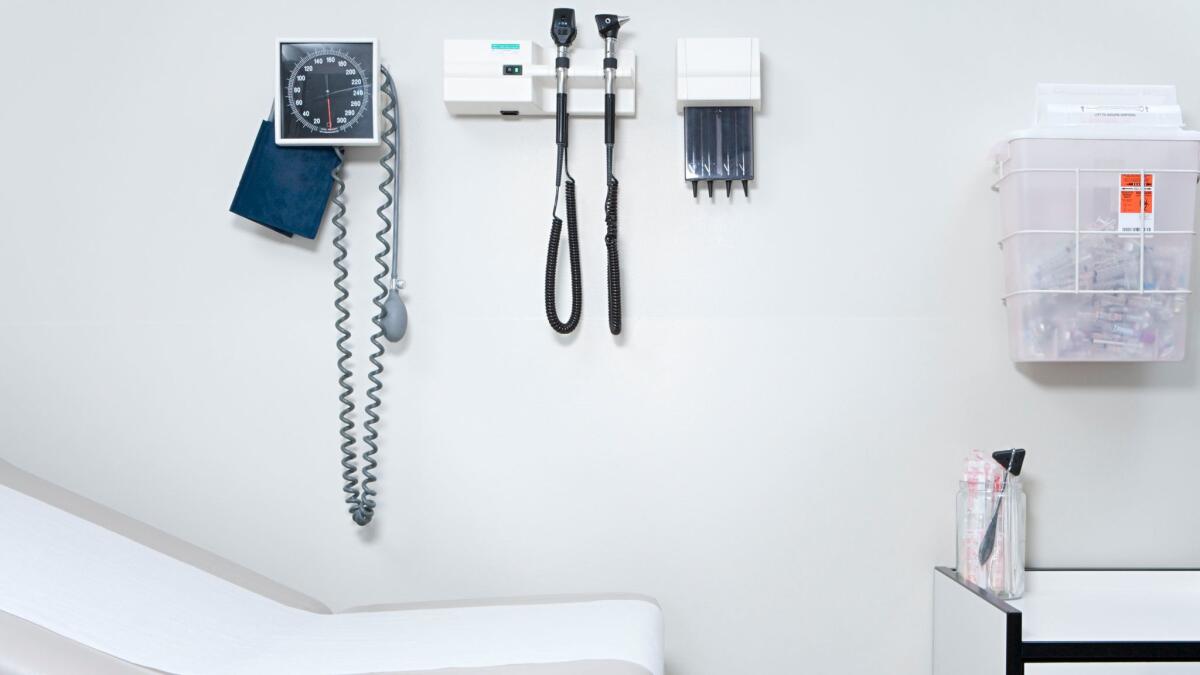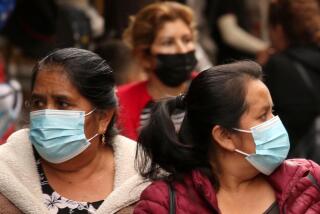Widening coronavirus crisis threatens to shutter doctors’ offices nationwide

- Share via
WASHINGTON — As hospitals in California and across the country struggle with a surge of coronavirus infection patients, a second crisis is brewing in physicians’ offices, threatening to push the nation’s healthcare system further to the brink.
Primary care physicians are being leaned on to keep patients out of hospitals, and to make do with limited protective equipment and other supplies. Yet they are seeing steep drop-offs in visits as patients stay away, fearful of getting ill.
These doctors have seen a big uptick in telehealth visits — a move widely hailed by public health experts — but the fees for these services are sometimes lower.
The developments are forcing growing numbers of physician practices to consider laying off staff, or even close their doors. And that’s stoked alarm that even more patients will end up in hospitals, at a time when every bed is needed to handle the widening coronavirus outbreak.
Doctors’ offices are “the front door to our healthcare system,” said Dr. Farzad Mostashari, a former federal and New York City public health official who now heads a company that helps primary care physicians manage their patients. “If primary care practices start to close and to get any healthcare you need to go to the emergency room, that’s just about the best formula for fanning the flames of this outbreak.”
Nevertheless, there are already signs that the pandemic is taking a toll on an increasing number of the approximately 500,000 primary care physicians in the U.S., including internists, family doctors and pediatricians.
In Enterprise, Ala., a rural community in the state’s south where physicians and nurses rallied after a tornado swept through in 2007, killing nine people, the number of paying patients has dropped 75%, according to Dr. Beverly Jordan, a family doctor there.
“At a time when we are struggling physically and emotionally to treat our communities … it is horrifying that we’re having to consider how we’re going to keep our doors open,” Jordan said. “We are hurting.”
Dr. Jasbir Gill is co-owner of an obstetrics and primary care practice that opened in 1953 and has four offices in California’s San Joaquin and Sacramento counties. Patient volume has fallen by half, Gill said, and he’s been on the telephone with banks to warn that checks might bounce, and to plead for loans.
In tiny Fredonia, Kan., Dr. Jen Bacani McKenney said she didn’t pay herself for the most recent period so she could pay her staff. And in Tucson, Dr. Leslie Willingham said doctors at her family practice are prepared to go without pay to keep the office open, even as all but emergency visits have been moved to telehealth.
“Each week, we are adapting, trying to stay open and keep patients out of the emergency room and pay our employees regular wages,” Willingham said.
The California Medical Assn. reported that it is already seeing some practices shutter. Nationwide, widespread closures may be just four to six weeks away, said Shawn Martin, senior vice president of the American Academy of Family Physicians.
For now, the strains are less acute for physicians who work in large health systems, many of which have more resources to respond to the crisis. But millions of Americans, particularly in rural regions of the country, still get their care from small- and medium-sized independent medical practices.
Many of these physicians’ offices were already struggling with inadequate supplies of masks and other protective equipment. Like medical facilities everywhere, they also haven’t been able to get coronavirus testing kits because of delays by the Trump administration in developing and disseminating them.
That made it important to keep as many patients as possible out of physicians’ offices to reduce the risk of infection being spread.
To compensate, many public health experts encouraged physicians to make greater use of telehealth, and the federal Centers for Medicare and Medicaid Services loosened rules to make virtual visits easier.
While some states, including California, have moved to equalize fees for virtual and in-person visits, states regulate only some health insurance plans. Large employers, who generally self-insure, are not subject to the state rules.
That means that primary care physicians often aren’t reimbursed at all for some virtual visits or, in some health plans, must refer their patients to other providers to do a virtual visit.
“It’s chaos,” said Dr. Christopher Crow, president of Catalyst Health Network, which helps about 800 Texas primary care physicians manage their patients. “Practices are seeing people, but all they can do right now is hope they get paid.”
Crow and some primary care advocates believe health insurance companies may be able to help prop up physician practices; as insurance claims have dropped, insurers are saving money they could share with primary care doctors.
One idea backed by Crow and others would have insurers pay physician practices an upfront fee to care for patients for the next several months instead of having doctors bill for each service they provide.
This would move away from the generations-old fee-for-service system, which many experts have long believed does not properly reward primary care doctors for keeping their patients healthy.
Many primary physicians are calling on the federal government to step in and prevent a wave of doctors’ offices from closing. On Tuesday, the U.S. Department of Health and Human Services announced $100 million to help community health centers, many of which have been struggling to help provide primary care to low-income patients across the country.
Advocates had pushed Congress to include federal grants and loans for primary-care physicians in a $2 trillion relief measure to address the coronavirus’ economic impact. But the package unveiled early Wednesday proposed $100 billion for medical providers in general, including hospitals and physicians.
Mostashari said aid can’t come soon enough. “The last thing these practices need to worry about in this pandemic,” he said, “is whether they can keep seeing patients.”
More to Read
Get the L.A. Times Politics newsletter
Deeply reported insights into legislation, politics and policy from Sacramento, Washington and beyond. In your inbox twice per week.
You may occasionally receive promotional content from the Los Angeles Times.











